
The papaya, papaw, or pawpaw is the plant Carica papaya, one of the 22 accepted species in the genus Carica of the family Caricaceae. It was first domesticated in Mesoamerica, within modern-day southern Mexico and Central America. In 2020, India produced 43% of the world supply of papayas.
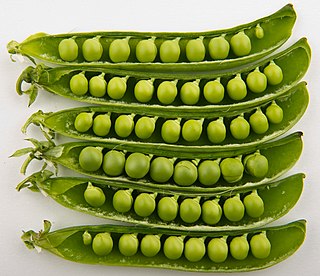
The pea is most commonly the small spherical seed or the seed-pod of the pod fruit Pisum sativum. Each pod contains several peas, which can be green or yellow. Botanically, pea pods are fruit, since they contain seeds and develop from the ovary of a (pea) flower. The name is also used to describe other edible seeds from the Fabaceae such as the pigeon pea, the cowpea, and the seeds from several species of Lathyrus.
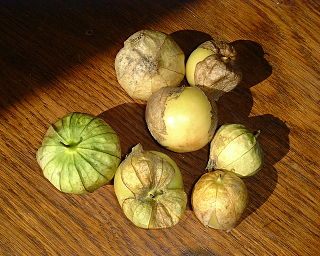
The tomatillo, also known as the Mexican husk tomato, is a plant of the nightshade family bearing small, spherical and green or green-purple fruit of the same name. Tomatillos originated in Mexico and were cultivated in the pre-Columbian era. A staple of Mexican cuisine, they are eaten raw and cooked in a variety of dishes, particularly salsa verde. The tomatillo is a perennial plant but is generally grown for agriculture each year as if it were an annual.
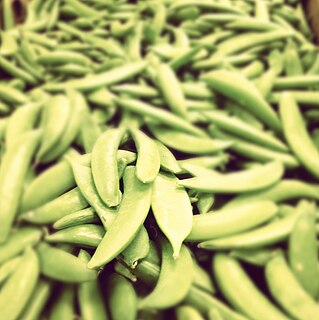
The snap pea, also known as the sugar snap pea, is an edible-pod pea with rounded pods and thick pod walls, in contrast to snow pea pods, which are flat with thin walls. The name mangetout can apply to snap peas and snow peas.

Green beans are young, unripe fruits of various cultivars of the common bean, although immature or young pods of the runner bean, yardlong bean, and hyacinth bean are used in a similar way. Green beans are known by many common names, including French beans, string beans, and snap beans or simply snaps. In the Philippines, they are also known as Baguio beans or habichuelas, to distinguish them from yardlong beans.

Ziziphus mauritiana, also known as Indian jujube, Indian plum, Chinese date, Chinese apple, and dunks is a tropical fruit tree species belonging to the family Rhamnaceae. It is often confused with the closely related Chinese jujube, but whereas Z. jujuba prefers temperate climates, Z. mauritiana is tropical to subtropical.
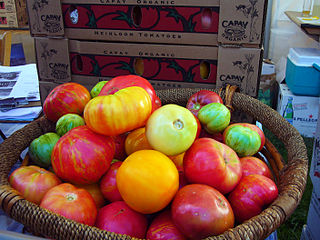
An heirloom tomato is an open-pollinated, non-hybrid heirloom cultivar of tomato. They are classified as: family heirlooms, commercial heirlooms, mystery heirlooms, or created heirlooms. They usually have a shorter shelf life and are less disease resistant than hybrids. They are grown for a variety of reasons: for food, historical interest, access to wider varieties, and by people who wish to save seeds from year to year, as well as for their taste.

Schisandra chinensis, whose fruit is called magnolia berry or five-flavor-fruit, is a vine plant native to forests of Northern China, the Russian Far East and Korea. Wild varieties are also found in Japan. It is hardy in USDA Zone 4. The fruits are red berries in dense clusters around 10 centimetres (3.9 in) long.

Garden Peach tomatoes are a cultivar of tomato, native South American fruit mainly from Peru. Its small, bright yellow fruit is the standard globe shape of tomato. With its yellow coloring, blushing vaguely pink mottling when very ripe, and fuzzy skin, it resembles a peach. This cultivar is also extremely prolific. It is rich in iron and vitamin B5. The plant grows naturally between 200 and 1,000 metres from Colombia to Ecuador and Perú.

Diospyros nigra, the black sapote, is a species of persimmon. Common names include chocolate pudding fruit, black soapapple and zapote prieto. The tropical fruit tree is native to Mexico, Central America, and Colombia. The common name sapote refers to any soft, edible fruit. Black sapote is not related to white sapote nor mamey sapote.

The Roma tomato or Roma is a plum tomato popularly used both for canning and producing tomato paste because of its slender and firm nature. Commonly found in supermarkets in some countries, Roma tomatoes are also known as Italian tomatoes or Italian plum tomatoes.

The tomato is the edible berry of the plant Solanum lycopersicum, commonly known as the tomato plant. The species originated in western South America, Mexico, and Central America. The Mexican Nahuatl word tomatl gave rise to the Spanish word tomate, from which the English word tomato derived. Its domestication and use as a cultivated food may have originated with the indigenous peoples of Mexico. The Aztecs used tomatoes in their cooking at the time of the Spanish conquest of the Aztec Empire, and after the Spanish encountered the tomato for the first time after their contact with the Aztecs, they brought the plant to Europe, in a widespread transfer of plants known as the Columbian exchange. From there, the tomato was introduced to other parts of the European-colonized world during the 16th century.
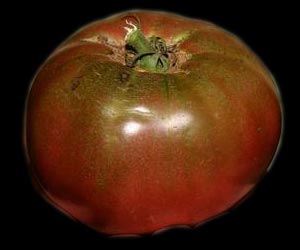
Cherokee Purple is the name of an old variety of tomato that develops a fruit with a deep, dusky-rose color while maintaining a somewhat greenish hue near the stem when mature for eating. The deep crimson interior and clear skin combination give it its distinctive color. It was one of the first of the darker color group of tomatoes sometimes described as "blacks." Southern Exposure Seed Exchange was the first seed company to offer Cherokee Purple, released in limited quantity in 1993. The Cherokee Purple has become a popular heirloom variety.

Tigerella is a bi-colored tomato cultivar, relatively small, 2 to 4 ounces, and early. Upon maturity the fruit is red with yellow stripes, essentially the same as Green Zebra, except that the fruit is red instead of green, and has a sweeter flavor. The colour occasionally varies, in New Zealand for instance, commercially produced Tigerella is dark crimson red with very dark green stripes.

Napa cabbage is a type of Chinese cabbage originating near the Beijing region of China that is widely used in East Asian cuisine. Since the 20th century, it has also become a widespread crop in Europe, the Americas and Australia. In much of the world, it is referred to as "Chinese cabbage". In Australia it also is referred to as "wombok".

Watermelon is a flowering plant species of the Cucurbitaceae family and the name of its edible fruit. A scrambling and trailing vine-like plant, it is a highly cultivated fruit worldwide, with more than 1,000 varieties.

Aunt Ruby's German Green heirloom tomatoes are a cultivar originating with Ruby Arnold, of Greeneville, Tennessee, but achieving great Seed Savers popularity. They are, as the name implies, "green" tomatoes, which really means they are a greenish yellow when fully ripe, but are still tasty when picked early.

Solanum macrocarpon otherwise known as the African eggplant : añara), Surinamese eggplant or Vietnamese eggplant is a plant of the family Solanaceae. S. macrocarpon is a tropical perennial plant that is closely related to the eggplant. S. macrocarpon originated from West Africa, but is now widely distributed in Central and East Africa. The plant also grows in the Caribbean, South America, and some parts of Southeast Asia. S. macrocarpon is widely cultivated for its use as a food, its medicinal purposes, and as an ornamental plant.

The Celebrity tomato cultivar is a hybrid (biology) that produces long fruit-bearing stems holding 20 or more very plump, robust tomatoes. Fruits weigh approximately 8 oz., and are 4 inches across. Plants need caging or staking, and produce fruit throughout the growing season. The celebrity tomato is a cultivar of the species Solanum lycopersicum. It is a crossbreed of the common tomato that is widely used for various culinary purposes. This tomato is of great size and is known to be resistant to most tomato diseases such as Fusarium wilt, Verticillium wilt, Tobacco mosaic virus and Root-knot nematode due to its hybrid nature. Celebrity tomatoes are highly adaptive to harsh environments and can grow in a wide range of places including dry, humid and wet regions. They are resistant to cracking and splitting which usually occurs when there is an excess of water and sugar movement in the fruits. Therefore, causing the tomato skin to grow at a slower rate compared to the expansion of the fruit. They can survive in harsh uneven rainfall. However, they are highly susceptible to colder environments and are at a higher risk of dying in regions with short growing seasons. The plants can grow up to 5 feet in height with bright red medium-sized fruits. The plants are generally very thick and grow in clusters. The tomato fruits are mostly used in the making of various salsas, salads, juices and canned food.





















